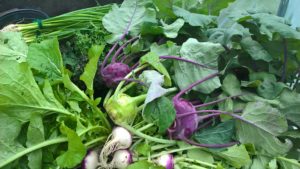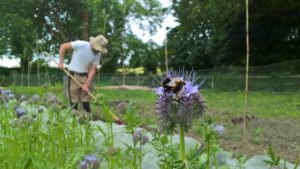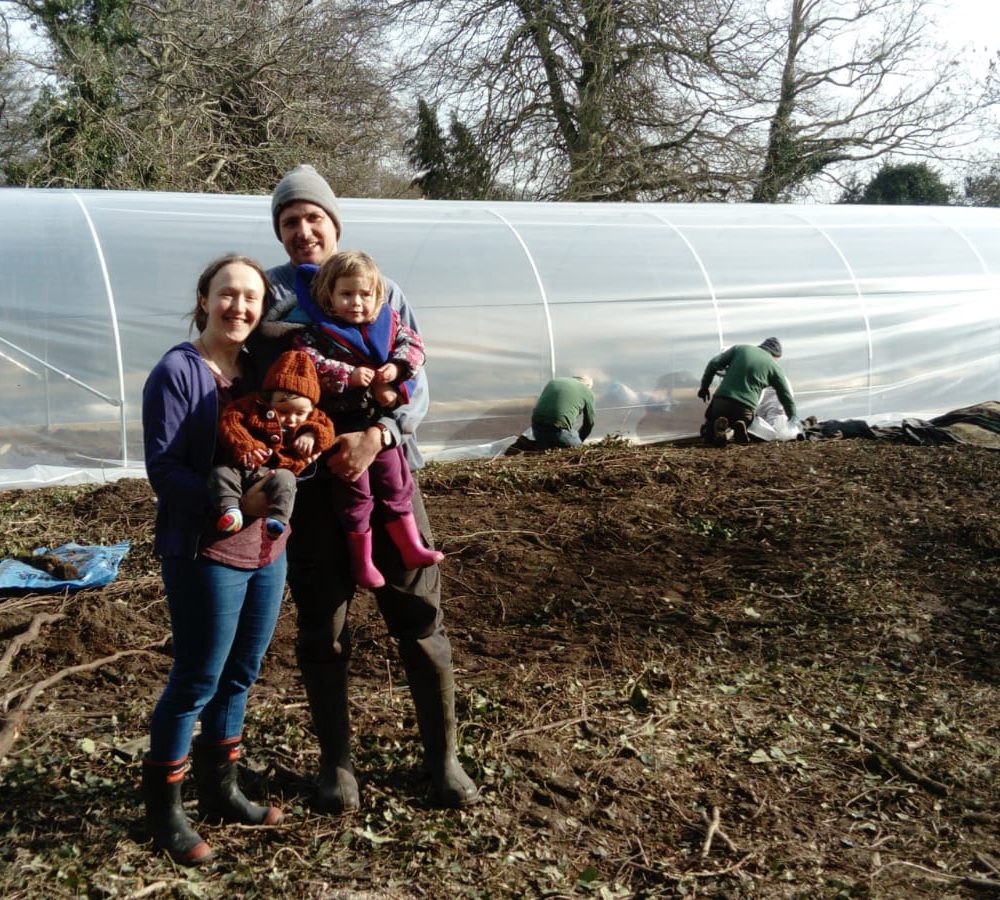
From the start, Charis Garden has been a community act: many different people are already part of the story, having given vital hands-on assistance, counsel or encouragement – not to mention the teeming crowds of creatures, above and beneath the soil, who make all the growing happen.
Our first blog post offers a glimpse into an unfolding journey of growth…
December 2017
Genesis. In the beginning there was jungle: a half-dead orchard, carpets of ivy, a forest of invasive bamboo with canes fifteen feet tall, clusters of nettle, dock and thistle. We begin with a spread of black silage tarp, enough to keep the soil warm through winter and block the rush of summer weeds.
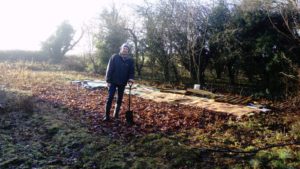
March 2018
To learn the basics of organic growing, Jeremy embarks on an apprenticeship at Moyleabbey Farm in nearby Ballitore. You can read about some of his experiences here: https://foodture.ie/2018/10/02/a-growers-diary/.
June 2018
Jeremy finds an old bee hive. Clueless, he decides to have a go at setting a bait hive to catch a swarm of bees. He adds a roof to the hive (a discarded fertiliser sack), a base (a section of old plywood) and sets it on a barrel in the shade of a horse chestnut tree, right in the middle of the teeming garden wilderness. Days later, he pays the hive a visit and, to his intense surprise and delight, discovers a bee colony has moved in.
A week later, David (Claire’s father) lifts another swarm out of a tree and places it in a second hive. Our beekeeping journey begins.

January 2019
We tackle the mighty tangle of bamboo. Canes are cut at the base with a heavy-duty strimmer or chainsaw and carried out of the garden by hand. The roots are forked up in the jaws of a silage grab and heaped in a corner of the garden.
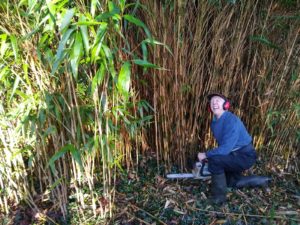
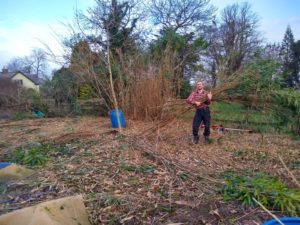
The tractor rips up the gnarled trunks of apple trees. We are careful to keep one tree intact: a reminder of the orchard that graced the garden in a former time.
The clearance work continues. The jungle slowly devolves into a blank, muddy canvas.
February
As his namesake suggests, David is a feller of giants. He guns his chainsaw and gets to work on a variety of towering sycamore and ash. One by one they fall. The vast trunks are then slowly sectioned up for firewood.
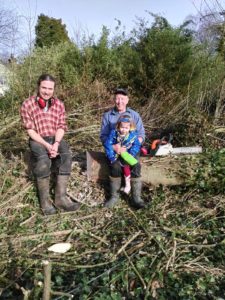
Trees can fall in unpredictable ways. One vast sycamore trunk landed a mere inch from the beehives situated near its base.

Vast tree stumps dot the bare soil. Raymond, a neighbouring farmer, shows up first with an antique digger and later, a giant JCB, to pull them up.
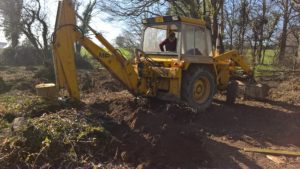
A brand new polytunnel is installed. Jeremy gets busy digging the beds inside, adding buckets of farmyard manure (supplied by neighbouring farmer) and coffee grounds (supplied by a busy local café) to bulk up fertility.

March
In the aftermath of tractor traffic and tree removal, soil is uneven and damaged in places. Work is slow. Beds are gradually formed with fork, shovel, rake and hands.
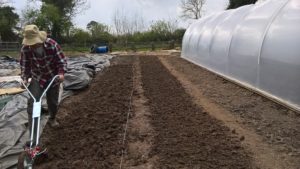
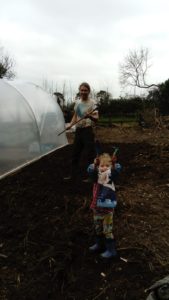
On March 7th Jeremy sows the very first seeds – beetroot, broccoli, kale, turnip, salads, kohlrabi, scallions and basil.
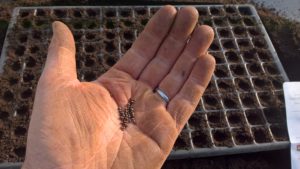
He clears the hedging that hugs the borders of the garden and replaces tumble-down fencing. Chicken wire is installed to deter rabbit entry.
From a stash of old windows, the Hot Box is built: our very own custom-made plant propagator. A heat blanket is added to provide the crucial warmth needed to spark the seeds. Over the coming months, the Hot Box provides the vital start for a whole host of heat-loving crops: tomatoes, aubergine, cucumber, bell peppers, courgettes, squash and pumpkin all begin life here.

Sowing continues throughout the month. Most seeds begin life in a seed tray. Once sapling-sized, they are ready to be transplanted into a bed. Potatoes are the first crop to be sown directly into open soil and fed with a generous dump of horse manure (provided by another neighbour.)
April
Work continues apace as the outdoor beds become more defined. The first salad crops are planted in the polytunnel.

The bee hives have sat in the same place since the day the bees first arrived, now almost a year ago. The work of garden transformation has hummed around them. Now Jeremy and David begin the task of moving them to the apiary area (recently an almost impenetrable heap of dead wood and ivy.) They decide the best option is to shift the hives, three feet a day, along a set of ladders.
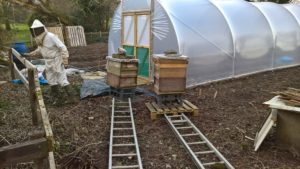
Onions, Fench beans, salads, kale, tomatoes: all these and more are beginning to green the bare soil of the garden. Jeremy constructs a French bean trellis out of the bamboo canes removed from the garden in January.

May
Both bee hives swarm repeatedly over a four week period. We go from two hives to six.
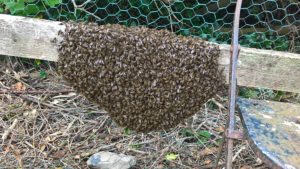
Meanwhile, the salad bed blooms. The first leaves are cut and savoured. Kale, purple top turnip, spinach, succulent head lettuce and coriander are harvested. We begin to share the wealth with neighbours and friends.
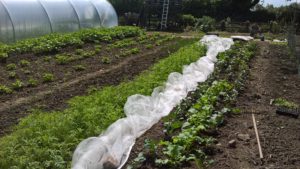
June
The garden is a riot of life. Beds of green manure burst with colour – clovers, Phacelia, sunflowers, marigolds – humming with bumble bees and hoverflies. The green canopies of the potato drills are thickening; the first Earlies will be harvested in the next fortnight.
Courgettes are beginning to bulge; tomatoes are forming in the tunnel beside the burgeoning cucumbers, scallions and beans. Bell pepper and aubergine plants are flowering. Hopefully, by summer’s end, we’ll be harvesting their succulent fruits.
